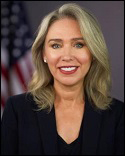By Pam Martens and Russ Martens: October 15, 2021 ~
On Tuesday, SEC Commissioner Allison Herren Lee delivered an exceptionally well-researched speech on the rising dangers to the broader U.S. economy from the burgeoning dark private markets for non-publicly traded stocks. She makes many important points.
However, there is a far larger and more dangerous dark market: the Dark Pools owned by the serially-charged mega banks on Wall Street that are trading, on a daily basis in darkness, the publicly-traded stocks that reside in public pension funds and the mutual funds that make up the bulk of retirement funds for tens of millions of Americans.
According to an April 2021 report from McKinsey & Company, “global private equity AUM [Assets Under Management] reached $4.5 trillion in the first half of 2020.” That’s the dark market that SEC Commissioner Lee is worried about.
The publicly-traded market in the U.S. stood at $54.768 trillion as of June 30, according to data from the Federal Reserve. That’s 12 times the size of the global private equity market. Which one do you think represents a greater threat to financial stability in the U.S.?
The SEC has admitted to being understaffed and underfunded. Shouldn’t it focus its limited resources on the biggest threats?
It’s not that the SEC hasn’t been put on notice for a long time now that what is going on in Wall Street’s Dark Pools is nefarious, and, highly likely, illegal.
In 2012, Crown Business published the book, Dark Pools: The Rise of the Machine Traders and the Rigging of the U.S. Stock Market, by Wall Street Journal investigative reporter, Scott Patterson. Patterson described the situation in 2012 as follows:
“…pools within pools, all connected electronically, forming a single sloshing pool of dark electronic liquidity. By 2012, the amount of stock trading that took place in dark pools and internalizers [Wall Street banks trading stocks in-house without the oversight of a stock exchange] was a whopping 40 percent of all trading volume – and it was growing every month.
“Even the lit markets were unfathomably complex, run by giant computers that processed secret trading strategies designed by physicists, chemists, Ph.D. mathematicians, AI computer programmers…
“All of that turnover was having a real-world impact on stocks. At the end of World War II, the average holding period for a stock was four years. By 2000, it was eight months. By 2008, it was two months. And by 2011 it was twenty-two seconds, at least according to one professor’s estimates. One founder of a prominent high-frequency trading outfit once claimed his firm’s average holding period was a mere eleven seconds.
“No one – no one – truly knew what was taking place inside the guts of this Frankenstein’s monster of a market.”
Dark Pools are even darker today than they were in 2012. But one thing we know for certain from the stale, aggregated data that is released by FINRA: mega Wall Street banks like Goldman Sachs, Citigroup, Bank of America Merrill Lynch and JPMorgan Chase are trading their own publicly-traded bank stocks in their own Dark Pools in thousands of transactions each week.
Are these banks using depositors’ money to buy back their stocks in their own Dark Pools? Nobody knows. Are they manipulating their share prices by trading in a cartel in these Dark Pools? Nobody knows. Why aren’t these banks allowing these trades to be exposed to the disinfecting sunlight of a regulated stock exchange? Nobody knows.
Following the stock market crash of 1929 which ushered in the Great Depression, the U.S. Senate Banking Committee conducted an extensive investigation over multiple years into the trading structure and trading practices on Wall Street. The Senate investigations focused on the collusive dealings of “pools,” which have today been reincarnated as Dark Pools with high-speed algorithms and pirates known as high-frequency traders. The 1930s Senate investigation found the following:
“A pool, according to stock exchange officials, is an agreement between several people, usually more than three, to actively trade in a single security. The investigation has shown that the purpose of a pool generally is to raise the price of a security by concerted activity on the part of the pool members, and thereby to enable them to unload their holdings at a profit upon the public attracted by the activity or by information disseminated about the stock. Pool operations for such a purpose are incompatible with the maintenance of a free and uncontrolled market.”
The Senate Banking Committee of 1934 concluded as follows:
“The conclusion is inescapable that members of the organized exchanges who had a participation in or managed pools, while simultaneously acting as brokers for the general public, were representing irreconcilable interests and attempting to discharge conflicting functions. Yet the stock exchange authorities could perceive nothing unethical in this situation.”
If the SEC wants to restore public confidence in U.S. markets, there is no better place to start than with Wall Street’s Dark Pools.
Related Articles:
The SEC Is Allowing 5-Count Felon JPMorgan Chase to Trade Its Own Bank Stock in its Own Dark Pools


